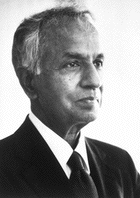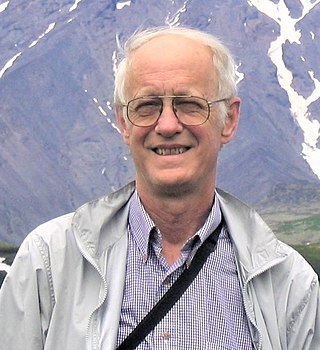
Subrahmanyan Chandrasekhar was an Indian-American theoretical physicist who made significant contributions to understanding of stellar evolution, black holes, and the structure of stars. He was awarded the 1983 Nobel Prize in physics along with William A. Fowler for "...theoretical studies of the physical processes of importance to the structure and evolution of the stars". His mathematical treatment of stellar evolution yielded many of the current theoretical models of the later evolutionary stages of massive stars and black holes. Many concepts, institutions, and inventions, including the Chandrasekhar limit and the Chandra X-Ray Observatory, are named after him.

Yousef Sobouti is a contemporary Iranian astrophysicist, theoretical physicist.
Eric Ronald Priest is Emeritus Professor at St Andrews University, where he previously held the Gregory Chair of Mathematics and a Bishop Wardlaw Professorship.

Peter Goldreich is an American astrophysicist whose research focuses on celestial mechanics, planetary rings, helioseismology and neutron stars. He is the Lee DuBridge Professor of Astrophysics and Planetary Physics at California Institute of Technology. Since 2005 he has also been a professor at the Institute for Advanced Study in Princeton, New Jersey. Asteroid 3805 Goldreich is named after him.
The MIT School of Science is one of the five schools of the Massachusetts Institute of Technology, located in Cambridge, Massachusetts, United States. The School, which consolidated under the leadership of Karl Taylor Compton in 1932, is composed of 6 academic departments who grant SB, SM, and PhD or ScD degrees; as well as a number of affiliated laboratories and centers. As of 2020, the Dean of Science is Professor Nergis Mavalvala. With approximately 275 faculty members, 1100 graduate students, 700 undergraduate majors, 500 postdocs, and 400 research staff, the School is the second largest at MIT. As of 2019, 12 faculty members and 14 alumni of the School have won Nobel Prizes.

Roger David Blandford, FRS, FRAS is a British theoretical astrophysicist, best known for his work on black holes.

George B. Field is an American astrophysicist.

Alexey Maksimovich Fridman was a Soviet and Russian physicist specializing in astrophysics, physics of gravitating systems and plasma physics. He discovered new types of instabilities in gravitating media, created the theory of planetary rings and predicted the existence of small Uranus satellites that were later discovered. He also developed the hydrodynamic theory of spiral structure in galaxies. Fridman worked at the Institute of Astronomy of the Russian Academy of Sciences, INASAN, and was professor at the Moscow Institute of Physics and Technology and at Moscow State University.

Priyamvada (Priya) Natarajan is a theoretical astrophysicist and professor in the departments of astronomy and physics at Yale University. She is noted for her work in mapping dark matter and dark energy, particularly in gravitational lensing and in models describing the assembly and accretion histories of supermassive black holes. She authored the book Mapping the Heavens: The Radical Scientific Ideas That Reveal the Cosmos.
The Institute of Space and Planetary Astrophysics, also known as by its abbreviation ISPA, is a premier and national research institute of the University of Karachi, engaging the theoretical and applied studies and research into topics pertaining to Astronomy, Astrophysics, Satellite Communication, Space Flight Dynamics, Atmospheric Science, Climatology, GIS & Remote Sensing and other related subjects. The institute has network of various mathematics and physics laboratories located in various universities of Pakistan, while it operates a single Karachi University Astrophysics Observatory.

Steven Andrew Balbus is an American-born astrophysicist who is the Savilian Professor of Astronomy at the University of Oxford and a professorial fellow at New College, Oxford. In 2013, he shared the Shaw Prize for Astronomy with John F. Hawley.

Oded Regev is a physicist and astrophysicist, professor emeritus of the Technion, Israel Institute of Technology. He is best known for his theoretical application of fluid dynamics and dynamical systems theory to astrophysics.
Vinod Krishan, is an Indian physicist, a Senior Professor and dean of sciences at the Indian Institute of Astrophysics, Bangalore. She is involved in teaching and research in Plasma Physics. She is a Fellow of the National Academy of Sciences, India and the 1991 recipient of the Vikram Sarabhai Award for Space Sciences.

Noam Soker is an Israeli theoretical astrophysicist. He was the chair of the physics department at the Technion – Israel Institute of Technology from 2009 to 2015.
Philippa K. Browning is a Professor of Astrophysics in the Jodrell Bank Centre for Astrophysics at the University of Manchester. She specialises in the mathematical modelling of fusion plasmas.
Masaaki Yamada is a Japanese plasma physicist known for his studies on magnetic reconnection.

Richard Van Evera Lovelace is an American astrophysicist and plasma physicist. He is best known for the discovery of the period of the pulsar in the Crab Nebula, which helped to prove that pulsars are rotating neutron stars, for developing a magnetic model of astrophysical jets from galaxies, and for developing a model of Rossby waves in accretion disks. He organized a US-Russia collaboration in plasma astrophysics, which focused on modeling of plasma accretion and outflows from magnetized rotating stars.

Nikolaos Kylafis is a Greek Theoretical Astrophysicist, who is professor emeritus at the Department of Physics of the University of Crete, Greece.
James E. Owen is an astrophysicist at Imperial College London who studies exoplanets and accretion disks.

Gary Joseph Ferland is an American astrophysicist. He is a professor of Physics and Astronomy at The University of Kentucky. He is best known for developing the astrophysical simulation code Cloudy, for his work on physical processes in ionized plasmas, and investigations of the chemical evolution of the cosmos.












